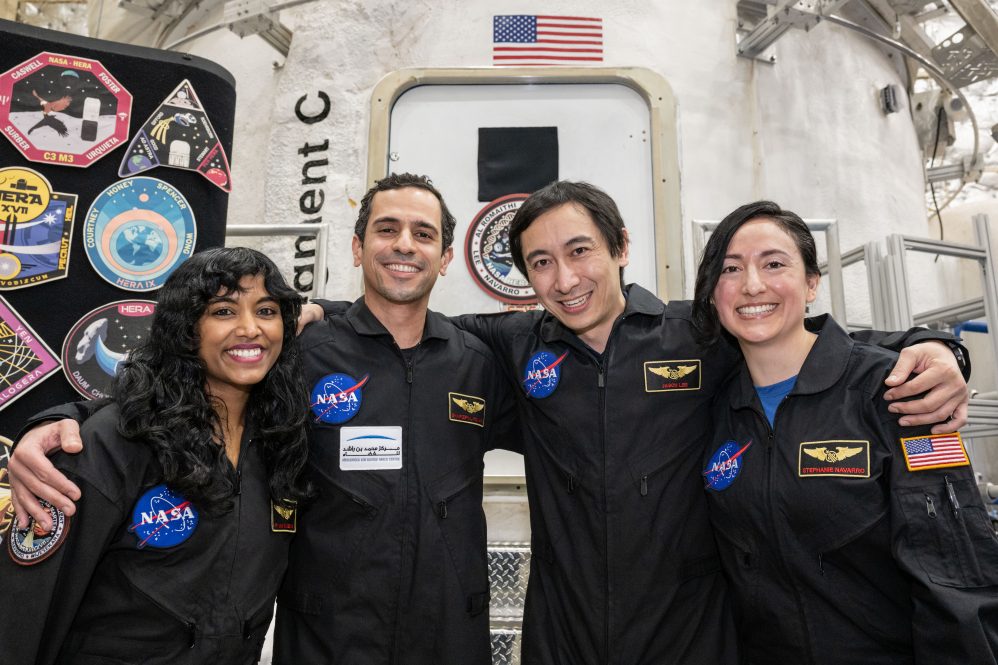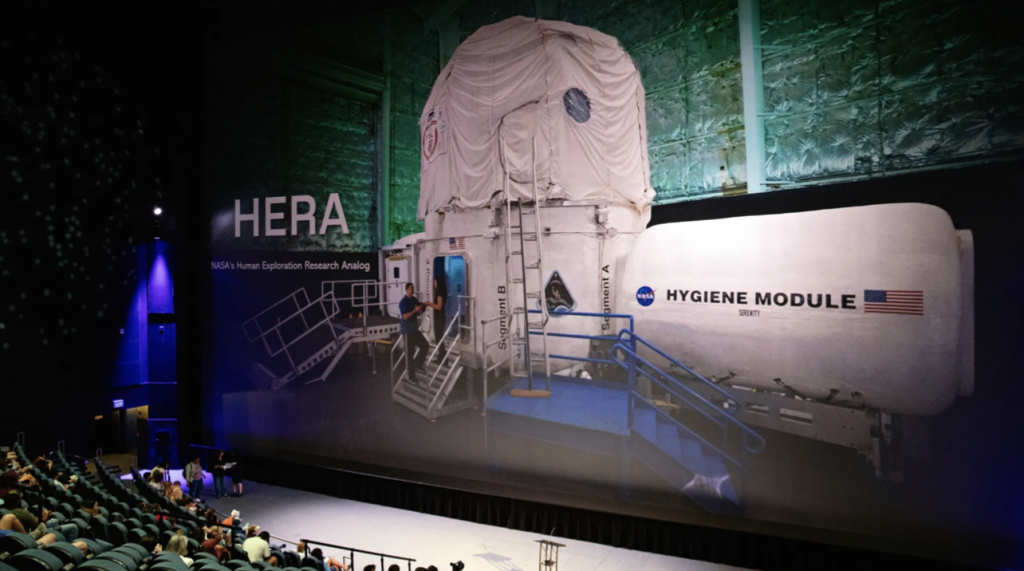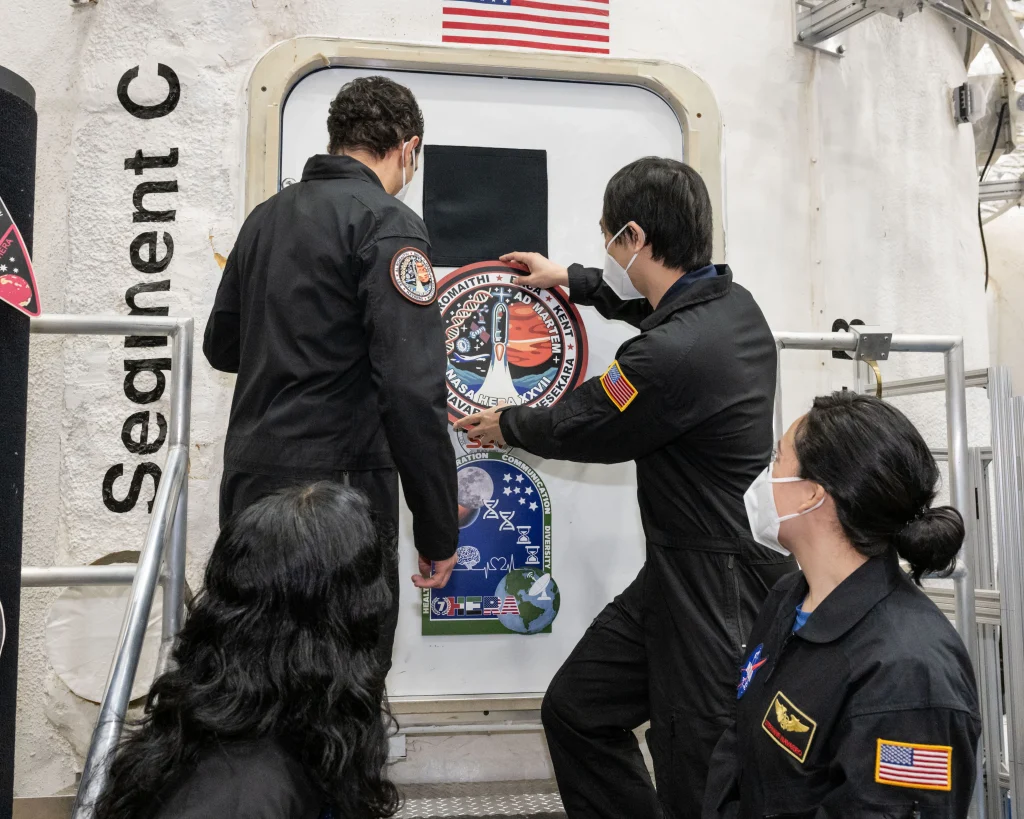By participating in the mission, College of Engineering's Jason Lee contributed to NASA's efforts to study how future astronauts may react to isolation and confinement during deep-space journeys

College of Engineering Associate Professor-in-Residence Jason Lee, pictured third from left, recently participated in a 45-day simulated space mission at the Johnson Space Center in Houston, Texas. Also pictured are his crew mates, Piyumi Wijesekara, Shareef Al Romaithi, and Stephanie Navarro. (James Blair/NASA)

Jason Lee's lifelong aspiration to explore outer space became a reality-without ever needing to leave planet Earth.
For 45 days, Lee, associate professor-in-residence in the School of Mechanical, Aerospace, and Manufacturing Engineering, lived in NASA's Human Exploration Research Analog (HERA) habitat at Johnson Space Center, participating in a simulated journey to Mars.
There, he and three other crew members operated in a constrained environment, completing mission-critical tasks, conducting repairs, viewing Martian landscapes through virtual reality, and making communication attempts with Mission Control.
"As a species we are in a constant state of seeking the unknown," Lee says. "That can be done in a good or bad way-so thinking about how to ethically and safely explore Mars is extremely important. The experience allowed me to contribute to the science needed to help the future of human space travel, while learning more about how astronauts train. I feel I got to see a sneak peek behind one of the curtains."
While in the habitat, NASA scientists conducted various experiments to assess the effects of isolation, confinement, team dynamics, biological changes, and remote conditions on the crew. Lee and his team frequently completed surveys to track their individual and collective well-being.
"I wanted to challenge myself mentally to stay in a confined space with strangers," Lee says. "The opportunity to be a test subject rather than an experimenter was intriguing to me."
Their mission, part of HERA's Campaign 7 Mission 2, contributes to NASA's efforts to study how future astronauts may react to isolation and confinement during long-duration space missions.
Inside the habitat, the crew worked a structured day, but also had leisure time. While they lacked access to phones or personal computers, they could play games, read books, watch movies, exercise, and listen to music. Once a week, they could connect with family members.
"Down time was an important piece of the simulation because avoiding burnout is important for long duration missions," Lee says. "I brought pictures of family and pets, had notes from family, and set routines to keep myself occupied. That was all very useful to have in the habitat."
The crew lived in a three-story, 650-square-foot structure. The first level contains the airlock, experiment stations, and the hygiene module (bathroom); the second level housed exercise equipment, individual workstations, and a kitchen area to rehydrate and heat food; and the third level-a loft accessed by ladder-contained sleeping beds. The crew's diet included dehydrated meals, nutritional bars, and canned soups and they grew lettuce hydroponically.
As their mission concluded, the HERA crew viewed footage from a previous mission to simulate their landing.

Lee, who teaches thermal fluids, manufacturing, and sports engineering at UConn and directs the NASA Connecticut Space Grant Consortium, plans to incorporate lessons from the HERA experience into his teaching. He intends to use insights on teamwork and stress management in his project-based classes.
Throughout the mission, crew members wore heart rate monitors to immediately see how stressors affected them physically. "I found just looking at the heart rate monitors and practicing breathing exercises could reduce those effects. I will be bringing these ideas back to my classroom to help students deal with their stressors such as preparing for a presentation or exam," Lee says.
Additionally, Lee is teaching the first-year honors seminar class UNIV 1784: Designing Life Support Systems for Humans in Space, where he'll help students design simulated life support systems for Mars and other lunar missions.
Lee credits his father, an aerospace propulsion engineer, for sparking his passion in space exploration. Lee recalls his father's home office teeming with rocket models and space-related patches, photos, and other memorabilia.
"He is the reason I became interested in engineering and since he passed a number of years ago, I have found I feel closer to him whenever I do work related to space," Lee recalls. "Just like many of my students, I have always dreamed of being an astronaut, and participating in this simulation mission helped me fulfill part of that dream."






